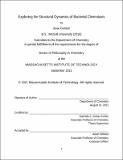| dc.contributor.advisor | Schlau-Cohen, Gabriela S. | |
| dc.contributor.author | Gordon, Jesse | |
| dc.date.accessioned | 2022-07-27T18:22:05Z | |
| dc.date.available | 2022-07-27T18:22:05Z | |
| dc.date.issued | 2021-09 | |
| dc.date.submitted | 2022-07-27T11:43:20.192Z | |
| dc.identifier.uri | https://hdl.handle.net/1721.1/144096 | |
| dc.description.abstract | Motile bacteria can track chemical gradients and adjust their swimming behavior using their chemotaxis system. The central components of the chemotaxis pathway are transmembrane chemoreceptors, which bind attractant ligands in the periplasmic domain and transmit ligand occupancy information through the cytoplasmic domain to inhibit a downstream histidine kinase that regulates motor control. Receptors are hypothesized to transmit this signal via dynamic structural changes in the >200 Å coiled coil cytoplasmic domain. However, the nature of the structural dynamics induced by ligand binding remains unclear. Additionally, to operate over a wide dynamic range of attractant concentrations, chemoreceptors undergo adaptational modifications in the adaptation region of the cytoplasmic domain, which are thought to impact the structural dynamics associated with signaling in the cytoplasmic domain. Single-molecule Förster Resonance Energy Transfer (FRET), which provides a nanometer scale ruler that enables the observation of protein conformations and dynamics, was applied to intact, functional chemoreceptor homodimers to observe ligand-induced changes. This thesis describes work to interrogate the structural dynamics of chemoreceptor homodimers associated with ligand binding, using single-molecule FRET. Chapter 2 describes the construction and characterization of a total internal reflection fluorescence (TIRF) microscope for use in single-molecule FRET measurements, which permits the observation of hundreds of single molecules in parallel. This enables the high-throughput screening of chemoreceptors with different labeling positions and adaptational states. Chapter 3 describes the observation of concerted differential changes in helical packing and dynamics within the cytoplasmic domain of a bacterial chemoreceptor homodimer induced by ligand occupancy in the periplasmic domain. In the presence of attractant ligand, the more dynamic pair of helices was observed to undergo an increase in interhelix separation and a further increase in dynamics. Conversely, the less dynamic pair remained low in dynamics and underwent a compaction. Chapter 4 describes preliminary work measuring the nature of ligand-induced signaling as a function of receptor modification state. Initial single-molecule FRET results suggest that the receptors in an adaptational modification state which inhibits kinase activity undergo an expansion similar to that described in the previous chapter for receptors shifted to a modification state which favors downstream kinase activity. | |
| dc.publisher | Massachusetts Institute of Technology | |
| dc.rights | In Copyright - Educational Use Permitted | |
| dc.rights | Copyright MIT | |
| dc.rights.uri | http://rightsstatements.org/page/InC-EDU/1.0/ | |
| dc.title | Exploring the Structural Dynamics of Bacterial Chemotaxis | |
| dc.type | Thesis | |
| dc.description.degree | Ph.D. | |
| dc.contributor.department | Massachusetts Institute of Technology. Department of Chemistry | |
| dc.identifier.orcid | https://orcid.org/0000-0002-3642-2112 | |
| mit.thesis.degree | Doctoral | |
| thesis.degree.name | Doctor of Philosophy | |
